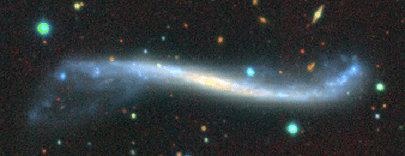The researchers from the Sloan Digital Sky survey have reported most detailed look at the warp of our home galaxia
Por lo general, uno piensa en espiral galaxias as a flat disc rotating around its centre but about 60-70% of the spiral galaxies including our home galaxia Milky Way have discs with a slight warp or twist.
No se sabía mucho sobre la deformación o torsión en nuestra casa. galaxia debido a la posición del sistema solar dentro de la Vía Láctea
The researchers of the Sloan Digital Sky Survey (SDSS), a consortium of several research organisations dedicated to creation of most detailed 3-dimensional maps of the Universo, after carefully studying the positions and motions of estrellas all over the Milky Way have traced out the warp. They have reported findings that the Milky Way’s disc is warped and the wrap travels around the galaxia una vez cada 440 millones de años.
The analysis showed that the twist or the warp is caused by the ripple or the wave travelling through the Milky Way causing individual estrellas to move up and down. The twist or the warp is continuing gravitational ripple passing through the galaxia caused most likely due to interaction with the satellite galaxia hace unos 3 millones de años.
Interestingly, our home galaxia Milky Way is expected to collide with the Andromeda galaxy in about 4 billion years from now when both the galaxies will merge with each other.
***
Fuentes:
The Sloan Digital Sky Survey 2021. Comunicado de prensa - La Vía Láctea hace la Ola. Publicado el 15 de enero de 2021. Disponible en línea en https://www.sdss.org/press-releases/the-milky-way-does-the-wave/
***






































